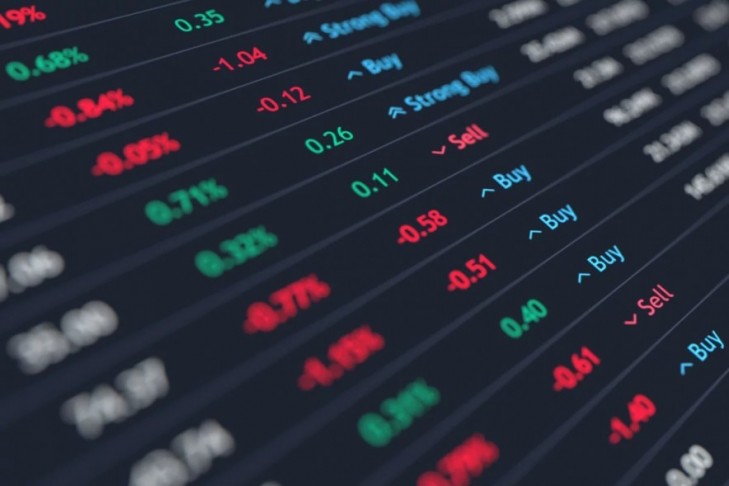
Algorithmic Crypto Trading: A Guide to Automated Crypto Trading Strategies
Jul 11, 2023, 7:49PMAlgorithmic cryptocurrency trading uses automated computer programs or bots to make trades based on a set of predetermined rules and strategies.
These algorithms can analyze large amounts of data, such as price and volume, to make split-second decisions to buy, sell or hold assets. This approach allows traders to react quickly to market fluctuations and potentially generate profits more efficiently than manual trading methods. Use an immediate connect platform and break into the world of trading without missing important events. However, it is important to note that algorithmic trading also comes with certain risks, so traders should do their due diligence before utilizing these tools.
Understanding Algorithmic Crypto Trading
Algorithmic crypto trading is the use of automated software to place buy and sell orders on cryptocurrency exchanges. The technology works by executing a set of predefined rules, or algorithms, that are designed to analyze market conditions and open or close positions based on specific indicators. This means that trades can be executed without human intervention, with machines placed in charge of monitoring markets and responding to signals.
To understand algorithmic trading, one can think about it like a self-driving car. Just as autonomous vehicles are programmed to make decisions based on road conditions and data from sensors, algorithmic trading relies on algorithms to make investment decisions. Trades are executed based on pre-set rules, such as timing, price targets, stop-losses, and indicators that might indicate a shift in market trends.
While this technology may sound like science fiction or something only large financial institutions would have access to, the truth is that the rise in popularity of cryptocurrency has led to an increase in algorithmic trading platforms that cater to retail traders. Anyone with a computer and internet connexion can participate in algorithmic trading.
For instance, many traders consider algorithmic trading as a tool for scaling up their operations. On exchanges with high liquidity and volumes, scalping requires speed in processing orders which can result in significant profits. In traditional manual trading, a trader identifies a profitable opportunity, such as fading a moving average crossover strategy at 1-minute intervals across several cryptocurrencies, by observing bid-ask spread discrepancies and waiting for the right time to fill his order books with limit orders. However, this process takes time and effort, which slows down the number of successful scalping operations.
To understand how this technology works, let’s dive into the definition and mechanism of algorithmic trading.
- According to a report by JP Morgan Chase in 2020, about 80% of all bitcoin trading is driven by machines that use algorithms.
- Research suggests that algorithmic trading accounts for approximately 60-73% or more of overall trading volume in the crypto market.
- A 2023 study revealed that top-performing crypto trading bots can increase returns by up to 36,205%, outperforming manual strategies.
- Algorithmic trading is a technology that uses automated software to place buy and sell orders on cryptocurrency exchanges based on predefined rules or algorithms. It is similar to a self-driving car as it relies on algorithms to make investment decisions. This technology has become popular among retail traders, providing them with an efficient way of scaling up their operations. Algorithmic trading allows for faster processing of orders, resulting in significant profits from scalping opportunities in high liquidity and volume exchanges. Understanding the mechanism of this technology is essential for anyone interested in participating in this rapidly growing field.
Definition and Mechanism of Algorithmic Trading
Algorithmic trading algorithms operate based on logical if-then sequences. They analyze large amounts of data in real-time and are designed to respond to specific events or market conditions. Essentially, an algorithmic trading system looks for patterns in the data it receives and uses those patterns to make predictions about future trades.
Understandably, the primary objective of this technology is to execute trades with great speed and accuracy, that is almost impossible to achieve manually. This speed allows the algorithmic trader to take advantage of small price movements that occur throughout the day. These price movements, called "micro-trends," add up over time if traded right.
Algorithmic trading has become the preferred method for large financial institutions such as hedge funds and investment banks, which need to process large amounts of transactions quickly. For example, Goldman Sachs is said to have made over $100 million per day in 2019 from computerized trading strategies.
Moreover, high-frequency traders (HFT) use algorithmic trading, where they send a high volume of trades within microseconds resulting in higher volumes making it difficult for regular orders with large spreads or limits transactions. While HFT strategies have come under criticism from some segments of traditional finance due to the spurious way its algorithms work, it's still a popular practice among major cryptocurrency exchanges.
While algorithmic crypto trading may seem like a one-way ticket to making money without lifting a finger, it’s not without its risks. One downside of algorithmic trading is that markets can be unpredictable and fast-changing. Algorithms are designed for certain conditions, so they may perform poorly when market conditions change suddenly.
Another pitfall is that if not used correctly, algorithms can amplify losses instead of gains. If an algorithm makes a flawed decision because of incorrect input data or programming errors, there could be significant losses on investments. It’s also important to note that as more people adopt algorithmic trading, competition increases, and potential opportunities decrease.
Similarly, one may think about an algorithmic trading system as a calculator. Just like pressing the right buttons on a calculator to solve a math problem, an algorithmic trading system must be programmed correctly to work efficiently. In the same way that an incorrect button press can lead to the wrong answer being displayed, incorrect programming of an algorithmic trading system can lead to significant losses.
In the next section, we'll dive into the pros and cons of algorithmic trading in detail.
Pros and Cons of Algorithmic Crypto Trading
Algorithmic crypto trading is becoming increasingly popular among traders, but it's not without its pros and cons. Here are some of the advantages and disadvantages you should consider before implementing an automated crypto trading strategy.
Advantages:
One of the most significant benefits of algorithmic trading is speed. Automated systems can execute trades in milliseconds, which can be crucial in a high-speed market like cryptocurrency. Moreover, algorithmic trading can help traders to remove emotions from their decisions, as they rely solely on pre-programmed rules and conditions rather than gut feelings.
Another advantage of algorithmic trading is scalability. Automated systems allow traders to process and analyse vast amounts of data with more accuracy while making quick decisions within that data domain. With advanced algorithms in place, traders can manage portfolios on a larger scale without becoming overwhelmed.
Disadvantages:
However, one downside of algorithmic trading is that it is entirely reliant on historical data being a predictor for future predictions. But wait, what if patterns change over time? Traders would need to adapt their strategies accordingly, given the changing market situations.
Another issue is that algorithmic trading systems might have bugs or errors leading to wrong financial decisions based on incorrect data sets or coding errors. Hence, it's essential not to completely trust automation as there is always room for error and mistakes.
Despite these potential drawbacks, it's important to weigh the pros and cons of algorithmic crypto trading carefully before deciding on a course of action.
Benefits of Automation in Crypto Trading
Incorporating automation into your crypto trading strategy has numerous benefits you should consider exploring.
Reduced Bias:
Emotions can affect our decision-making abilities, which can lead to disastrous results in trading. Automated systems remove any emotional bias from the equation by basing decisions purely on pre-established parameters. In contrast, traders could get carried away by emotions and forget the rational evidence of data-backed strategies leading to bad trading performance.
Increased Efficiency:
As previously mentioned, automated systems can execute trades in milliseconds, which makes them more efficient than human traders. Human beings are slow decision-makers compared to computers or AI. Imagine competing with a computer that's processing information ten times faster than you – daunting, right?
Automated strategies can also speed up market analysis as they are capable of monitoring several markets at once, 24/7. Additionally, algorithms can potentially identify profitable patterns sooner than traditional traders would have been able to do.
Improved Risk Management:
There is a consistent risk when it comes to trading in cryptocurrencies due to its high volatility. However, the implementation of automation can mitigate that risk by enabling for building in stop-loss orders or "panic buttons" if prices fall below certain levels, thereby minimizing losses.
However, there is a debate about whether automated trading increases risk since there is no emotional human experience in determining what might be an acceptable loss versus gain, while others argue that programmed rules-based trading minimizes the potential for risky speculative activity.
As we've seen in this section, automation brings a host of advantages and benefits to crypto trading. So now that you know the pros and cons, let's explore some popular automated tools and platforms suited for crypto trading!
Pitfalls in Algorithmic Crypto Trading
While algorithmic crypto trading has the potential to maximize profit and minimize risks, it is not without its pitfalls. Like any other investment strategy, there is no surefire way of achieving guaranteed returns with algorithmic trading. Here are some potential pitfalls that you should take into account before entering the world of automated crypto trading:
One common pitfall is seen in blindly relying on bots or algorithms without monitoring them. Even the most sophisticated algorithm can be flawed, and market conditions can change quickly. Without a human element to oversee and adjust trading strategies as necessary, an automated bot may continue to execute losing trades.
Another challenge when using algorithms in crypto trading is that an algorithm trader needs to have a complete understanding of the code they're working with (or pre-written strategies by developers). While commercial platforms work on a plug-and-play basis, self-built solutions call for a thorough knowledge of programming languages used in creating one's own strategies.
It's important to remember that automated trading isn't magic; the efficacy of these programs relies on strong fundamentals and technical analysis based on numerous factors. There is also a learning process involved – where individual traders must understand how bots behave differently from manual trading.
Lastly, many people worry that relying too much on machine-based decisions takes away control from humans and cedes it over to machines. Even though these robots are incredibly useful tools for making instantaneous trades thanks to their speed and accurate analysis, it is essential to ensure that traders remain in control at all times and continue making their own informed decisions
Key Strategies in Algorithmic Crypto Trading
Algorithmic crypto trading offers several different approaches, each having its strengths and weaknesses. Each strategy uses different parameters like back-testing historical data to identify profitable trades or real-time market data feeds that use technical indicators. Some of the popular key strategies that traders use include:
Trend-following is one of the most common strategies used in cryptocurrency trading algorithms and involves identifying asset trends from historical data. This strategy aims to take advantage of an established trend by buying when a market is on an uptrend, then selling when it starts to fall or vice versa.
Mean reversion is another popular algorithmic trading strategy that relies on identifying overbought and oversold assets. This strategy looks for deviations from the mean and takes advantage of market corrections. Buy low, sell high is potentially the most fundamental strategy, but its principal strength lies in combining fundamental analysis with technical analysis.
News-based trading is a new trading strategy that leverages news events such as official announcements made by crypto companies, or policy changes pegged to cryptocurrencies. It can be worthwhile taking note of these significant announcements, as they could add liquidity and volatility to assets previously not seeing much volume.
Pair trading, referred to as statistical arbitrage, analyses two assets' price correlation and works on the premise that, over time, they will respond similarly to common factors affecting their prices. When these two assets deviate from each other's price discovery, it identifies market inefficiencies where trades may take up both positions simultaneously.
Exploring Algorithmic Crypto Trading Tools and Platforms
Now that we've discussed the benefits and pitfalls of algorithmic crypto trading let's dive deeper into exploring the key tools and platforms available for automation. As mentioned earlier, these tools can help both new and experienced traders make money in the challenging crypto trading space.
One popular tool is Cryptohopper, an automated bot for managing all crypto exchange accounts in one location. It allows users to trade cryptocurrencies like Bitcoin, Ethereum, and more across multiple exchanges simultaneously. Cryptohopper also provides its users with technical analysis indicators, customizable trading strategies, backtesting tools, price alerts, and a user-friendly interface.
Another top platform is 3Commas, which offers sophisticated trading options in an approachable package ideal for solo traders who want to use more complex methods. Users can create personalized trading bots with a drag-and-drop editor or choose from readymade trading bots designed by other successful traders. Additionally, 3Commas has features such as trailing stop-loss orders, grid bots for dollar-cost averaging strategy, and social trading to follow other traders' portfolios.
Stoic is another promising algorithmic trading platform that assists users in converting digital assets into long-term equity investments. It automatically manages a diversified cryptocurrency portfolio that includes any or all currencies on Binance. What sets Stoic apart from its competitors is its human touchpoint feature; if you need expert opinion or guidance regarding your investment plan, you can get in touch with their PhD-trained investment team.
Finally, Shrimpy is yet another comprehensive crypto investing platform providing algorithmic trading, and portfolio management services coupled with helpful performance monitoring features. Users are allowed to adjust different metrics like the weights of their chosen assets in the portfolio or simply copy other investors' portfolios through Shrimpy's social algorithm.
These are just a few examples of the many automated tools available for crypto traders today. As more people explore automated trading and the demand for such tools increases, we can only expect to see further innovations in this space. In fact, according to a recent market research report, the algorithmic trading software market size is expected to reach $26.0 billion by 2026.
Various studies have also indicated that these platforms outperform traders who use a manual method. One study by Blockchain Capital even suggested that algorithmic trading produces profits with less volatility and reduces overall risks during trades, thereby increasing profit margins.
However, just as there are pros and cons of algorithmic trading itself, different platforms have their benefits and drawbacks as well. It's crucial to do your own research before selecting any platform or tool to understand how it works and what level of customization it offers, as well as its pricing structure and user assistance capabilities.
Additionally, some traders argue that automation can be too rigid and inflexible when dealing with rapidly changing market conditions. They argue that there is still a place for human decision-making in trading scenarios since an algorithm must depend on past data patterns to make predictions about future developments.
Therefore, it's essential to lay out clear objectives for automated trading strategies so that traders can program and execute them predictably and consistently. Traders require accurate tools that provide real-time data insights and facilitate decision-making in volatile crypto markets while taking into account emerging trends.
To put it in perspective - automated trading tools perform similarly to a personal assistant who helps prioritize tasks based on set parameters. They allow you more time for other important activities like researching new investment opportunities or simply having more leisure time for yourself.
Ultimately, algorithmic crypto trading tools offer many advantages over traditional manual methods of trading. However, choosing the right algorithmic crypto trading tool depends on individual preferences such as budget constraints, complexity of requirements, and levels of technical expertise, among others. In a rapidly evolving space like crypto trading, the importance of identifying the right tool for the job is paramount.
Disclaimer: information contained herein is provided without considering your personal circumstances, therefore should not be construed as financial advice, investment recommendation or an offer of, or solicitation for, any transactions in cryptocurrencies.

















